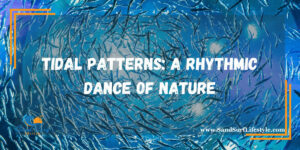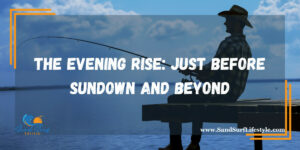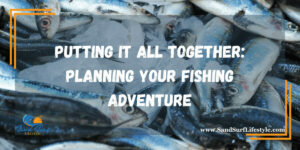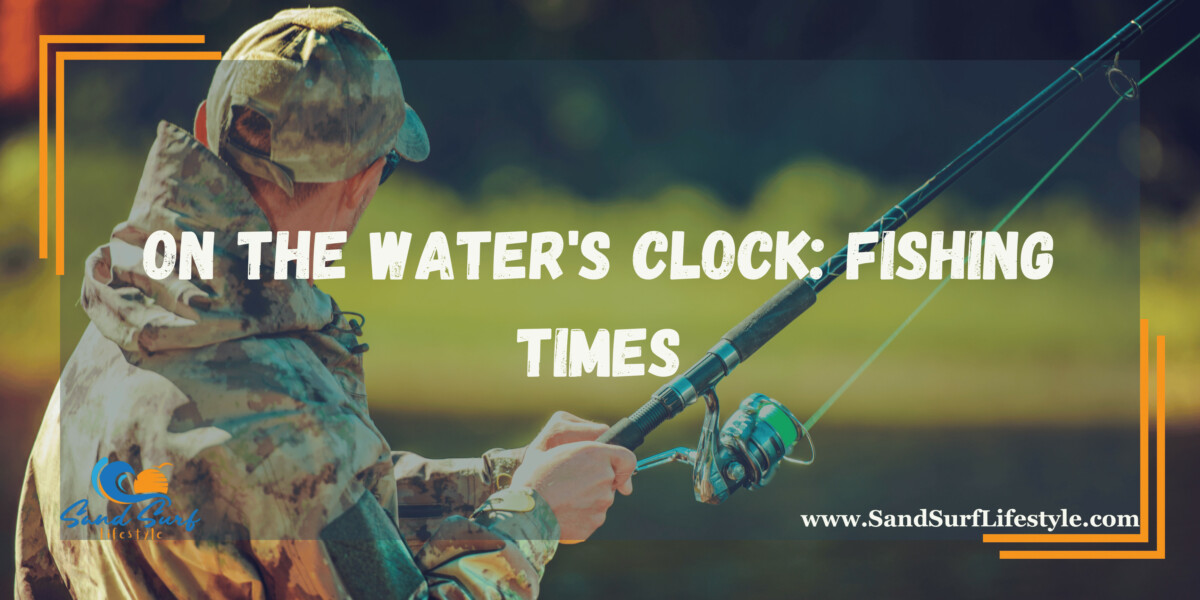Fishing is as much an art as it is a science. While experienced anglers will tell you that luck plays a role in landing the big catch, there’s more to it than mere chance. Understanding the best fishing times is crucial for increasing your chances of success. These optimal times are influenced by tidal patterns, the sun’s position, and the moon’s phases.
Tidal Patterns: A Rhythmic Dance of Nature

The ebb and flow of tides stand as a fundamental force in shaping fish activity, exerting their influence in a perpetual, rhythmic dance. These tidal movements are the tangible outcome of the celestial tug-of-war between the moon and the sun’s gravitational forces acting upon our Earth’s oceans. The resulting phenomena showcase two high tides and two low tides each day, setting the stage for a constantly evolving aquatic ecosystem.
During high tides, a cascade of effects unfolds. As the ocean surges inland, it carries with it a wealth of nutrients, microorganisms, and smaller marine life forms. This tidal influx acts as a dinner bell for a myriad of fish species, beckoning them to the shallow, nutrient-rich zones near the coast. Here, amidst the swirling mélange of sustenance, fish find a veritable feast. These high-tide feasts fuel growth and provide a prime opportunity for anglers seeking to capitalize on the feeding frenzy.
Conversely, low tides herald a different scenario. As the tide retreats, fish are compelled to navigate closer to the shoreline, where water depths are less imposing. This migration in search of nourishment and safety brings them within reach of patient anglers. The ebb of the tide reveals strategic ambush points for predatory fish, making low tides an equally promising time for those casting their lines.
To learn about fishing license expenses, check out this article.
High Tides: A Bounty of Opportunity
Fishing during the one hour before and after high tides is a well-practiced strategy among seasoned anglers, and for good reason. When the high tide rolls in, it carries with it a banquet of natural riches that transform the aquatic world into a thriving buffet for hungry fish. As the water level rises, it sweeps over submerged terrain, stirring up a flurry of nutrients and enticing prey species from their hideaways.
This influx of sustenance triggers an irresistible feeding frenzy among various fish species, as they seize the opportunity to replenish their energy reserves. The shallower waters near the shoreline become a prime hunting ground, attracting not only the predator fish but also the baitfish that come to graze on the newly arrived nutrients. For anglers, this convergence of factors creates an ideal scenario for success.
Casting your line during the high tide hours allows you to position your bait or lure in the midst of this aquatic abundance. The odds of enticing a catch are significantly heightened during this time, making it a period cherished by anglers seeking to land that trophy fish.
Low Tides: A Window of Opportunity
Conversely, the one hour before and after low tides offers an equally enticing opportunity for anglers to make their mark. As the tide recedes, it reveals the secrets of the shoreline, exposing submerged structures and creating pathways for fish to venture closer to the coast.
Fish, often forced to move to shallower depths during low tide, become concentrated in these areas. The fish’s proximity to the shore makes them more accessible targets for anglers. Whether you’re casting from the beach, a pier, or a boat, this is the moment to capitalize on their vulnerability.
During low tide, you can employ a variety of techniques, such as sight fishing, as the clearer, shallower waters allow you to spot fish more easily. By strategically positioning your bait or lures in the path of these transient fish, you increase your chances of a successful catch.
The Sun’s Influence: Rise and Shine, or Set and Score
Beyond the gravitational dance of tides, the sun’s celestial journey through the sky is a pivotal factor in orchestrating fish behavior. It delineates two significant phases in the angler’s quest, where the sun’s presence or absence significantly impacts the outcome of a fishing expedition.
The Morning Rise: After Sunup for a Spell
The “morning rise” stands as the first gleaming window of opportunity for anglers, unfolding just after the sun ascends above the horizon, painting the world in a gentle, golden hue. During this period, nature awakens from its nocturnal slumber, and fish, ever responsive to environmental cues, undergo a notable transformation.
As the sun’s rays kiss the water’s surface, the temperature begins to climb, initiating a warming process that rouses fish from their resting states. This increase in water temperature invigorates aquatic life, energizing fish and enticing them to become more active. Their movements become more pronounced, and they often venture closer to the water’s surface.
The allure of the morning rise lies in the fact that fish are more likely to be found in shallower waters. This makes it an ideal moment for anglers to employ surface or shallow-water fishing techniques. The relative ease of targeting fish in these zones increases the likelihood of a successful catch.
The Evening Rise: Just Before Sundown and Beyond

Conversely, the enchanting “evening rise” unfolds during the twilight hours, just before sundown, and extends for about an hour or so afterward. This period marks a crucial transition for fish as they prepare for their nocturnal hunting activities. Similar to its counterpart, the morning rise, the evening rise holds a magnetic allure for anglers, presenting a prime opportunity to secure remarkable catches.
As the sun begins its descent below the horizon, a magical transformation transpires beneath the water’s surface. Fish, in anticipation of the approaching darkness, embark on their evening ritual of increased activity. They rise from deeper waters, migrating closer to the surface. This ascent is driven by their instinct to hunt under the cover of night.
The “evening rise” encapsulates the essence of this extraordinary transformation, providing anglers with a precious window to engage with fish at the height of their activity. The dwindling light enhances visibility, enabling anglers to spot and target their prey effectively. Casting lines during this period often leads to exhilarating encounters with fish that are eager to feed and, in turn, rewards anglers with a bountiful harvest.
Lunar Cycles: The Moon’s Silent Influence
While the sun commands the skies, the moon exerts its silent but substantial influence on fishing through its gravitational mastery. The moon’s gravitational pull gives rise to the rhythmic dance of tides, a phenomenon that plays a pivotal role in fish behavior.
The rise and set of the moon act as subtle prompts for changes in fish activity. During these lunar transitions, fish often adjust their behavior in response to the evolving tide levels. When the moon rises or sets, the shifting tides can trigger feeding or movement patterns in fish, creating opportune moments for anglers.
Moreover, the moon’s phases, such as the full moon, new moon, and half moons, have distinct effects on fish behavior. The full moon, for instance, bathes the waters in bright light, making it easier for both fish and anglers to navigate. Conversely, the new moon casts a shroud of darkness, challenging anglers to employ stealthy techniques. Understanding the moon’s phases and their influence on tides and fish behavior adds another layer of knowledge for those seeking to master the art of fishing.
Rise and Set of the Moon: A Subtle Shift in Activity
The rise and set of the moon, while less conspicuous than the sun’s daily journey or the dramatic ebb and flow of tides, wield a subtle yet undeniable influence on fish behavior. During these understated lunar transitions, fish are known to recalibrate their activity levels, responding to the shifting tides in a delicate dance of adaptation.
While the moon’s impact is not as overt as other factors, it is a nuanced consideration when planning fishing trips. Fish may become subtly more active or adjust their feeding habits during these lunar shifts. Anglers who pay heed to these changes can gain an edge in optimizing their strategies for different phases of the moon.
Full Moon: Bright and Bustling
The full moon, often illuminating the night sky in all its glory, is a phase associated with increased fish activity. Its radiant light enhances visibility in the water, making it easier for both predators and prey to navigate the aquatic realm. Consequently, fish become more confident in their movements and hunting patterns.
For anglers, a full moon offers a double advantage. With better visibility, you can more precisely target your desired species. Additionally, the increased fish activity heightens the chances of successful catches during nighttime expeditions, particularly in areas with minimal light pollution.
New Moon: A Dark and Mysterious Time
Conversely, the new moon marks a time of darkness when the moon is barely visible or entirely absent from the night sky. Fish can be more cautious in this dimly lit environment, making them less inclined to feed aggressively. However, this challenging scenario can work to an angler’s advantage.
During the new moon, employing stealthy techniques becomes crucial. Fish are less likely to detect the presence of anglers, making it an opportune moment for those who relish the thrill of the hunt. Using lures that emit enticing, glowing features can also prove effective in attracting curious fish in the absence of natural light.
Half Moons: A Balance Between Light and Dark
Half moons occupy a middle ground in terms of lunar visibility. During these phases, fish typically exhibit a moderate level of activity. While they may not be as frenzied as during a full moon, they are not as cautious as during a new moon.
This balanced state of lunar illumination can work in an angler’s favor, offering a sweet spot for those seeking to capitalize on fish activity without the challenges posed by excessive brightness or darkness. Anglers can plan their outings with reasonable expectations of good fishing opportunities during half-moon phases.
Putting It All Together: Planning Your Fishing Adventure

Now that we’ve explored the various factors influencing the best fishing times, let’s discuss how to integrate this knowledge into your fishing expeditions.
Consult Tide Charts
Begin your fishing planning by consulting local tide charts specific to your chosen fishing location. Tide charts are invaluable tools that provide accurate information about high and low tide times. These charts not only inform you about the timing of tidal changes but also give insights into the magnitude of these changes. Armed with this information, you can meticulously plan your outings, ensuring that you’re at the right place at the right time. Tide charts help you optimize your fishing experience, taking full advantage of the dynamic conditions created by tidal patterns.
Sunrise and Sunset Times
A fundamental component of fishing success is being attuned to the natural rhythms of the day. Researching the sunrise and sunset times for your area is a non-negotiable step in this process. The “morning rise” and “evening rise” are intricately tied to these celestial events. Knowing precisely when the sun graces the horizon and when it bids adieu to the day’s light is crucial. These times dictate when fish tend to become more active and when their feeding habits intensify. Armed with this knowledge, you can synchronize your fishing trips to coincide with these pivotal moments, increasing your chances of a successful catch.
Lunar Phases
The lunar calendar is a treasure trove of information for avid anglers. By keeping a watchful eye on the moon’s phases, you can gain a deeper understanding of how lunar cycles impact fish behavior. Whether it’s the full moon, half moon, or new moon, each phase has its unique influence on the underwater world. For instance, the full moon bathes the surroundings in light, facilitating both predator and prey movements, while the new moon challenges anglers with its darkness. Tailoring your fishing trips to align with specific lunar phases allows you to harness these lunar influences, making your outings more strategic and rewarding.
Local Knowledge
The wisdom of local anglers and fishing guides is an invaluable resource. These individuals possess a wealth of firsthand experience and intimate knowledge of the region you plan to fish in. They can offer invaluable insights into the best times to fish in specific spots, the habits of local fish species, and even the most effective bait or lures to use. Local knowledge is a shortcut to success, as it provides you with a level of understanding that transcends what can be gleaned from charts and calendars. By tapping into this collective wisdom, you can enhance your fishing prowess and make the most of your time on the water.
Adapt and Experiment
Fishing is as much an art as it is a science, and it demands adaptability and a willingness to experiment. Conditions on the water can be unpredictable, and fish behavior can vary from day to day. As such, it’s essential to embrace the dynamic nature of fishing and be prepared to adjust your strategy on the fly. If one approach isn’t yielding results, don’t hesitate to switch things up. Try different times, techniques, bait, or lures. Experimentation is a powerful tool in the angler’s arsenal, allowing you to adapt to changing conditions and ultimately improving your chances of landing that elusive trophy fish.
To learn about choosing the best fishing rod, check out this article.
Conclusion
Fishing is more than just dropping a line in the water and hoping for the best. It’s a pursuit that rewards those who understand the rhythms of nature and how they affect fish behavior. By paying attention to tidal patterns, the sun’s position, and lunar cycles, you can maximize your chances of success on your next fishing adventure. So, set your alarm clock for the morning rise, grab your gear for the evening rise, and embrace the subtle influence of the moon—it’s time to unlock the secrets of the best fishing times.
Please note that the contents of this blog are for informational and entertainment purposes only and should not be construed as legal advice. Any action taken based on the information provided in this blog is solely at your own risk. Additionally, all images used in this blog are generated under the CC0 license of Creative Commons, which means they are free to use for any purpose without attribution.

